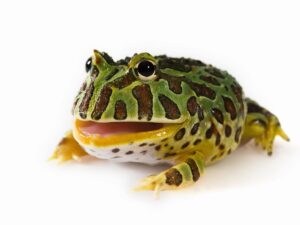🐸 Pacman Frog Feeding Tongs: Tips for Safe Feeding
How to Feed Your Frog Without Stress or Injury
Pacman Frog Feeding Tongs - At a Glance
Feeding tongs are the safest way to offer live or frozen food to your Pacman frog. Use soft-tipped, non-metal tongs to avoid mouth injury, and always feed gently and deliberately. This method reduces stress, keeps your hands safe, and encourages a strong feeding response.
Feeding your Pacman frog with tongs isn’t just a convenience—it’s a safety measure for both you and your amphibian friend. While their feeding lunge may look slow-motion, their bite is surprisingly fast and powerful. Using the right tongs and feeding technique protects your frog’s mouth and avoids accidental bites.
In this guide, you’ll learn:
Why tongs are essential for safe feeding
The best types of tongs to use
How to feed with tongs properly
Common mistakes to avoid
Tips for getting a shy frog to eat
Why Use Feeding Tongs?
Pacman frogs rely on ambush-style feeding, striking suddenly when prey gets close. Feeding tongs help:
✅ Keep Your Hands Safe
Pacman frogs have strong jaws and tooth-like ridges. A direct bite can hurt!
✅ Protect the Frog’s Face
Tongs allow precise placement, reducing the risk of substrate ingestion or face injury.
✅ Control Prey Movement
Especially helpful for frozen-thawed food or slow-moving prey like worms.
👉 What Do Pacman Frogs Eat? Complete Feeding Guide
👉 How Often Should You Feed a Pacman Frog?
Choosing the Best Feeding Tongs
How to Feed Your Frog Without Stress or Injury
Best Materials
| Material | Why It Works |
|---|---|
| Silicone-tipped tongs | Soft grip, prevents mouth injuries |
| Bamboo tongs | Gentle and natural, lightweight |
| Plastic reptile tongs | Affordable and safe for soft mouths |
Avoid:
Bare metal tongs: Risk of injuring lips or teeth
Sharp-edged tips: Can cause cuts during fast strikes
Tongs shorter than 6 inches: May put fingers too close
How to Feed With Tongs Safely
Step-by-Step Feeding Guide:
Warm up the prey (if frozen-thawed)
Gently grip the food item with the tongs
Hover the prey just 1–2 inches in front of the frog
Wiggle slightly to mimic natural movement
Let the frog strike—do not push the food into its mouth
Release immediately once it grabs the prey
Remove uneaten food after 15–20 minutes
Pro Tip: Always feed from the same spot in the enclosure to create routine and reduce stress.
Common Feeding Tong Mistakes
| Mistake | Why It’s Harmful |
|---|---|
| Using metal tongs with no tips | Can crack or bruise the frog’s jaw |
| Dangling food too high | May stress the frog or cause them to miss |
| Wiggling food too much | Can confuse or exhaust a shy frog |
| Forcing food into mouth | Increases risk of aspiration or refusal |
| Touching the frog with tongs | Seen as a threat—never poke or tease |
What If My Frog Doesn’t Take Food From Tongs?
Don’t worry—many frogs take time to adapt to tong feeding. Try this:
Rub prey along the frog’s upper lip to trigger a strike
Feed closer to the ground to simulate a crawling bug
Offer at night when the frog is most active
Make sure the enclosure is warm enough (75–85°F)
FAQ: Feeding Tongs and Frog Safety
Q: Can I use my fingers instead of tongs?
A: Not recommended. Pacman frogs can bite hard and mistake fingers for food.
Q: How long should feeding tongs be?
A: Ideally 8–12 inches long to keep your hands at a safe distance.
Q: Can I reuse tongs between frogs?
A: Yes, but sanitize them first to avoid cross-contamination.




